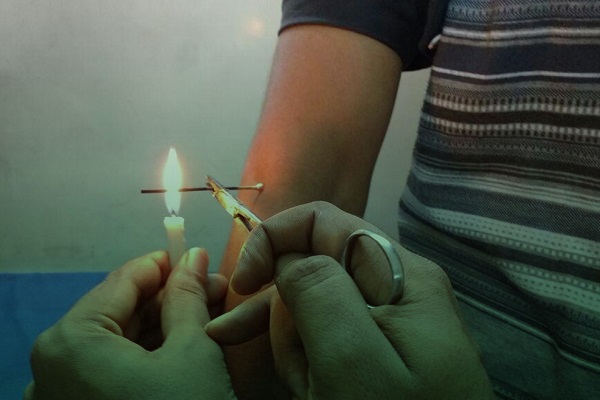Words: Drs Anil Kumar SAH & Bijendra SHAH
The term, agnikarma [thermal microcautery], is made up of two words agni, for ‘fire’ and karma’ for ‘procedure. This is defined, in Ayurveda, as the procedure by which agni is used for the treatment of various diseases.
Agnikarma is an ancient Ayurveda treatment procedure for pain management — it has a history of at least 3,000 years.
Acharya Charaka describes agnikarma under 36 upakramas of vrana — in the chapter Dwivraniyachikitsha.
Acharya Suśruta focuses on a separate chapter, Agnikarma Vidhi Adhyaya, for the explanation of agnikarma. In Suśruta’s Uttartantra, this is one of 60 upakarmas of vrana. In chapter 40 of Sutrasthana of Astanga Samgraha, a detailed description of Agnikarma is also found.
The 30th chapter in Ashtanga Hridaya [Sutrasthana] explains agnikarma. Acharya Harita mentions agnikarma as an important treatment procedure for various diseases.
Dalhana describes agnikarma as Agni Krita Karma, where agni is used directly for the procedure and Agni Sambandhi karma, where Agni is used indirectly for the procedure. Based on the dravya used, this can be classified as Snigdha Agni Karma [The used materials are madhu, taila, ghrita, etc.,] and Ruksha Agni Karma [pippali, shalaka, ajasakrida, etc].
Acharya Suśruta mentions valaya [circular shape], bindu [dot-like shape], vilekha [different shapes made by heated shalaka], pratisarana [no specific shape and rubbing of heated shalaka at a specific site], based on akriti.
Acharya Vagbhata mentions three extra types of agnikarma, based on akriti — they are ardha chandra [crescent shape], astapada [specific shape containing eight limbs in different positions], and swastika [shape of swastika yantra].
Agnikarma is mentioned after chhedan in diseases like arsha, kadara, etc., after bhedana in diseases, like fistula, sinus, etc, and filling by the guda in diseases like Krimidanta, etc. Agnikarma is also narrated as sthanik [local] and sthanantariya [systemic]. On the basis of dhatu, agnikarma twaka dagdha, sira and snayudagdha, mamsa dagdha, and asthi sandhi dagdha are envisaged. Agnikarma is classified, based on dagdha bheda, into plushta dagdha [scorched burn], dur dagdha [blistered burn], samyaka dagdha [superficial burn], and ati dagdha [deep burn].
Agnikarma produces the following signs and symptoms on respective dhatus.
In Twaka Dagdha, agnikarma is done on twaka, while producing a crackling sound, bad odour, and contraction of the skin.
Mamsa Dagdha Agnikarma produces discoloration like a pigeon, mild pain, inflammation and dried lesion.
Sira Snayu Dagdha creates black discoloration, swelling of the lesion, and cessation of discharge, while sandhi and asthi dagdha cause dryness, hardness, redness, and fixation of the lesion.
According to the Suśruta, all the dagdhas fall under the four Dagdha Vrana. If the shalaka used for the procedure of agni karma is not heated properly, Plustha Dagdha is seen. The site is affected by a burning sensation. It is related to the burn of the first degree.
Drugs of ushna virya should be administered to patients.
Dur Dagdha primarily occurs when there is unusual mobility of either unskilled surgeons, or patients due to fear. It is related to the burn of the second degree. Patients should be administered both warm and cold therapies.
In Samyaka Dagdha, there is anaawagandha vranata [not deep wound], talphala varnata [blue-black colour fruit of the tall tree], susamshita vrana [lack of elevation and depression]. Ati dagdha occurs when an excess of heat is transferred from shalaka yantra to the diseased part. Gatra-vishlesha, mamsa-avalambana, jwara, daha, pipasa, murcha etc are the symptoms seen.
All the seasons, except grishma [summer] and sharada [autumn] are considered the best seasons for the agnikarma procedure. In an emergency, agnikarma can be performed during grishma and sharada by adopting certain precautions.
Agnikarma is indicated in excessive pain in twaka, sira, mamsa, asthi, sandhi, snayu, arsa, shlipad, charmakil, antravrudhi, siracheda, shiraroga, puyalasa, abhisyandhi, arbuda, lingarsha, yonyarsha, bhagandar, krimidanta, adhidanta, sheetadanta, kadara etc.
Acharya Suśruta mentions that agnikarma should not be practiced in pitta prakriti, bala, vriddhi, daurbalya, bhinna kostha, bhiru, etc.
A person with a large number of varnas is not suitable for swedana karma. They should not go for this procedure.
Acharya Charaka mentions that agnikarma should not be done in varna of marma, snayu, netra, kustha, visha, and shalya.
According to Astangasangraha, agnikarma should not be done in a person suffering from atisar, boils, or takes virechana. Such patients are not suitable for ksharakarma.
Agnikarma is considered superior among all the parasurgical procedures, because there are no chances of reoccurrence of disease. Agnikarma can also treat diseases that cannot be treated with ksharakarma, medicines etc.
Dr ANIL KUMAR SAH is a BAMS Scholar and Dr BIJENDRA SHAH, BAMS, MS [Shalya Tantra], FARC [Anorectal] is Teaching Assistant, Ayurveda Campus and Teaching Hospital, Kirtipur, Kathmandu, Nepal. This piece [A Review Article on Agnikarma in Ayurveda] was first published in The Healer Journal, 2022;3[1]:1-9, under a Creative Commons License 4.0 [Subject Photo: Courtesy: Tvasta Ayurveda].

